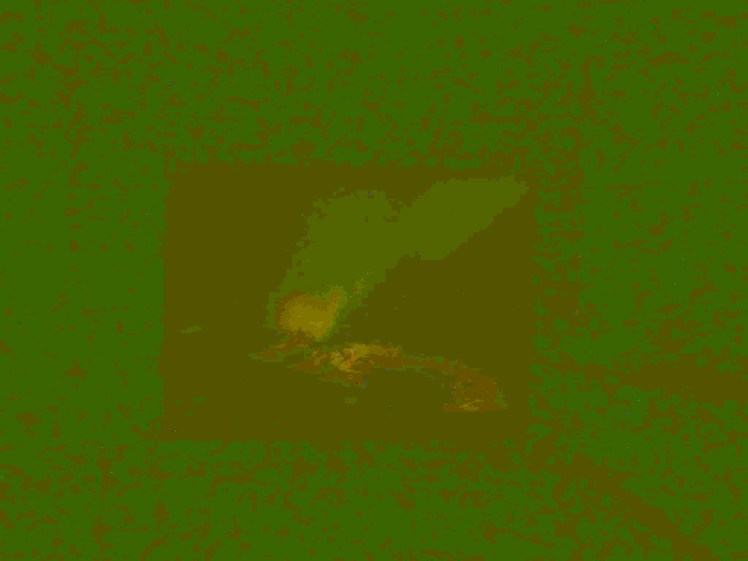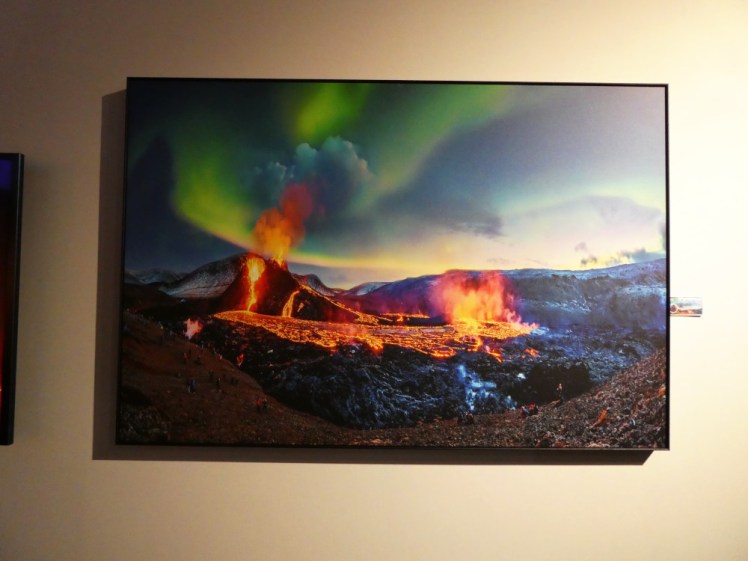It’s mid-May – at least, in my plan it is – and I’m finally delivering the last of the February 2023 Iceland posts! Well, I still have plans to tear RE apart in a long essay but this is the last of the proper “what I did” posts. I hid from the snow and the cold in Aurora Reykjavik, where the Northern Lights are guaranteed.

It’s quite an unprepossessing building on the side of the Old Harbour, with its nice pink and green aurora logo over the door. They make up for the lack of size by putting in partition walls turning the whole place into a bit of a labyrinth and every wall is covered with either a big shiny photo of the Northern Lights (usually over a spectacular bit of scenery, like an erupting volcano or the glacial lagoon) or an information board. There are three main rooms. The first is what I’m calling the science room – it’s the one with the information, and the TV screen explaining how the Northern Lights actually work, and the Thing in the corner that I’m just gloating over.

Like the Whales, there’s an audioguide if you’ve got your phone and headphones. I’ve never been in the habit of taking my headphones out and about with me, so I didn’t have them. I only ever use them on a plane and I walked over to Grandi, so I didn’t listen to the tour. I didn’t really feel I needed to. There’s plenty of information and between boards, screens and interactive things, I got my education quite satisfactorily.

I’d already been to Perlan and seen its aurora cinema quite recently but it’s always interesting to see another version of what causes the Northern Lights – the more you know, the more you can piece together your own mental tapestry of it. I suppose I’m a reasonably sciency person and I do understand the interaction between charged solar particles and particles in our atmosphere but I still prefer to explain it as “imagine the solar wind striking off our atmosphere like a match on a matchbox” and I like to have more of a picture of how it all works than a lecture of it. This little film explained the solar wind as being like an elastic band, a flare of solar particles stretching away from the sun until it breaks, flying past Mercury and Venus and then being sucked back by Earth’s magnetic field, funnelled to the two poles. I guess Earth doesn’t capture all of them because Jupiter, Saturn, Uranus, Neptune and several of the solar system’s moons all have their own Northern Lights. Uranus and Neptune have UV lights, which you can’t see with the naked eye and I think Saturn’s might be too.

But my favourite thing is the Northern Lights in a Jar. You know plasma balls? Those glass balls that have little electrical storms raging from the centre, where the lightning follows your hands when you touch it? Well, they had a tube a bit like that. A long purple cloud flickers up and down the tube, like a wide loose plasma lightning strand but when you bring your hands near or when you touch it, it turns into a green haze – a miniature Northern Lights show caused by some kind of interaction between my hand and the purple flare. I have no idea how it works and I can’t find any way to buy one of my own (it would undoubtedly be far too expensive anyway) and in fact, no evidence that such a thing exists. But it does, I saw it and I think it’s awesome. The closest I can find is that NASA created a Planeterrella which you can see at the universities of Southampton and Leicester but it’s still nothing like Aurora Reykjavik’s Northern Lights in a Jar. Honestly, it was worth the price of admission to play with this thing.
The second big room is the Aurora cinema where you can sit on a chair like a civilised person or lie on the floor on a beanbag like me, and watch an endless carousel of spectacular Northern Lights photos. I think this documentary lasts about forty minutes. Actually, it’s a tiny bit disappointing. All the photos are taken by brilliant photographers but because they’re brilliant photographers, they want to show off the landscape at the same time, so a lot of them appear to be lit by the full moon or the photos have been processed in some way and the Northern Lights aren’t as vivid and high-contrast as I’d like to see them. I can take weak, pale photos myself. I can take photos of snowy mountains at night myself. I want to see the bright greens and vertical curtains and details that make people think that’s what they look like rather than what they actually look like. The Northern Lights aren’t as bright as you think and I suppose it’s not a bad thing for the Aurora centre to show the reality rather than the over-edited ideal – but if I’m going to lie on the floor for forty minutes, I want to see that over-edited ideal. I think you can buy the film on DVD but honestly, just go raid YouTube.

The third room is the photo room. In here, it explains the Kp index – that’s basically the strength of the interaction, showing how far south it’s travelling but broadly, if you’re in an auroral region, it’s a measure of how bright the Northern Lights are likely to be – and shows a map of the Kp and it also has a Northern Lights photobooth, a sealed-off black box where you can try out your camera settings so you know how to take photos of the real thing. I don’t like the settings on my current camera so I’ll sometimes take an old semi-functional camera if I think I’m going to be taking photos of the sky, and to prove it, here’s my attempt at taking a photobooth photo of the Northern Lights:

The unedited version is a plain black square with no lights visible whatsoever. It’s only when I pull the saturation up so high that I turn everything green that I can see what I presume is Northern Lights over a volcano. Well, the lava would be very visible, even at night so no matter how badly I messed up my settings, it wouldn’t look like this. This, for me, has not been a lesson in photographing the Northern Lights. I’ll stick to my own advice from several years ago.
You can also stand outside the photobooth and use the automatic postcard machine to create a photo of you admiring the Northern Lights. I had to take my glasses off for this because it uses a ring light which doesn’t look good on lenses and I retook it at least four times. They show you where to look and even after discovering that that’s not the right place and trial-and-error on finding a better sightline, it’s still highly unconvincing, isn’t it?

I was told that there’s a 360 VR Northern Lights experience, which I thought would be in this room but I didn’t see it. Didn’t see it in the science room either. As per usual, the website is very vague – I would personally put on a map of the building, showing what’s where so you don’t miss big things like the aurora VR. I’d have liked to try that.
And then you’re done. It’s a very small place, although it’s tightly enough wound that they pack more in than you’d expect. Then you find yourself in the shop. Iceland has no shortage of postcards, t-shirts and assorted other tourist nicknacks in the puffin shops but if you’re after some art – proper art, in frames or acrylic blocks, this might be the place for you. Grab yourself a copy of their Aurora photo of the year – and it’s pretty spectacular. If I had the wall space, I’d absolutely get a high-quality print of it.

While you’re in the Grandi area, you’ve got plenty of other options, by the way. It’s a couple of minutes up the road to the Saga Museum, and then easily under ten minutes to any of FlyOver Iceland, Whales of Iceland and Lava Show Reykjavik. I didn’t go there myself but there’s the Reykjavik Maritime Museum and plenty of places to eat and drink around the edge of the Old Harbour. So it’s definitely worth taking a day out in Grandi and popping into Aurora Reykjavik for an hour.
2 thoughts on “Guaranteed Northern Lights at Aurora Reykjavik”